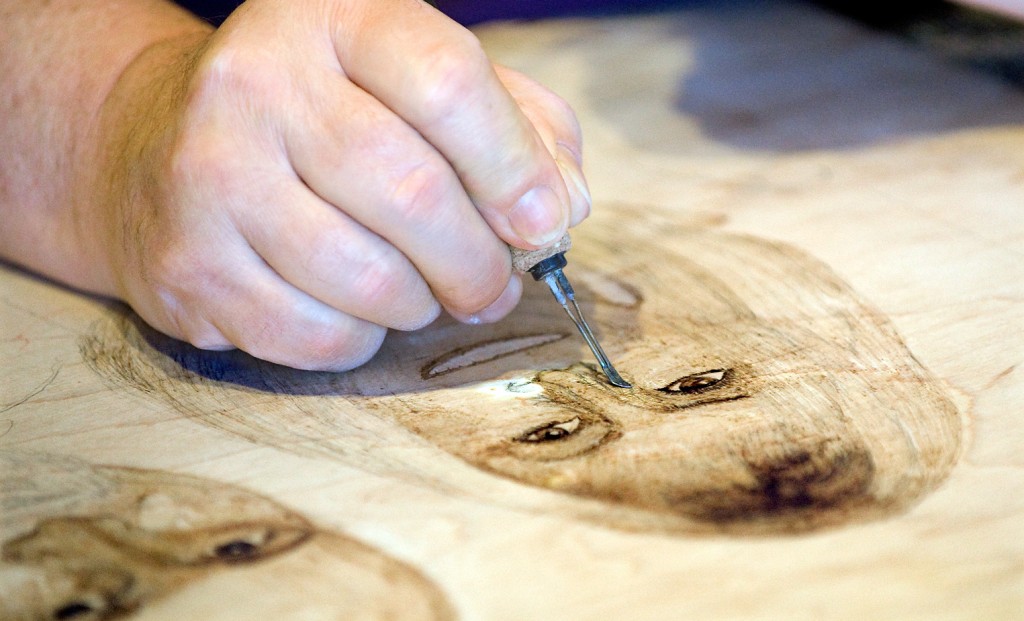Courtesy Daily News Record, Feb. 7, 2012
A scroll through David Kreider’s website is like a trip around the world: guest book entries from the Netherlands and France to Vermont and California. His artwork depicts faces from places as far off as the Middle East or Africa, and landscapes from New Zealand to the Blue Ridge Mountains.
His personal journey has led him from Israel to Harrisonburg. The latest grain in his path, teaching pyrography – literally “writing with fire” – began with a knock on his door last year.
On a trip to Harrisonburg from his home in Stanley, Bob Hebron arrived on Kreider’s doorstep. He’d seen his wood-burning works in a publication about pyrography.
Drawn to meet the artist on a whim, Hebron asked if Kreider would offer personal instruction.
“It was a little unorthodox,” Hebron laughed. “But, hey, here I am.”
Half a year later, they sit in Kreider’s studio ready for their weekly class – a portrait in progress in front of them.
Hebron has been a woodcarver for years, but the similarity stops at the material; Kreider notes that carving is about texture, while pyrography focuses on shading and detailed work with the wood-burning pen tool.
Therapy, Trauma
Kreider received a wood-burning pen as a gift from his grandparents when he was a preteen living in Israel. He finished high school abroad and came to the states for college at then- Eastern Mennonite College.
But art and intercultural connections didn’t click until years later, after visiting an artist-friend in the Gaza Strip in 1983.
He eased into an interest in art while self-employed as an auto mechanic. Eventually, his interest in cultures and faiths led him to the Center for Justice and Peacebuilding, graduating in 2009. Still, his artistic tendencies stayed on the back burner.
Processing what he’d learned and experienced at CJP, he said he began “thinking about bringing in arts as a way of engaging … relating the pursuit of meaning” to express oneself through symbols and images.
“It was like a whole other language that makes it possible to communicate in ways that words often can’t get a hold of,” he said. “That whole integration had a lot to do with my finding this convergence in arts and peacebuilding and spirituality; it’s a way of capturing deeper meaning.”
Participating in and co-leading workshops at CJP and with undergraduate classes at EMU, Kreider has facilitated works such as stained glass and mixed media collaborative pieces. One in particular, still in progress, began in a workshop a year and a half ago.
Each member of the group – bringing diverse experiences from across the world – wrote various bits of personal information on chunks of glass. Their life stories, relationships and aspirations were then “broken” into pieces and reconnected to parts of each other’s stories.
Their pasts represented a variety of traumas, from being child soldiers or victims of rape to losing a loved one. Kreider said the purpose of such collaborative art efforts is to demonstrate “how all of that can kind of fit together into something beautiful, even out of what is essentially broken pieces of glass,” and creating a memorial of the process.
“It becomes [not only] a point of healing and hope and identification with the pain,” he said, “but also with finding meaning and connecting with other stories, too.”
Breaking Barriers
Although they haven’t spoken much about his work in trauma transformation and intercultural work, Hebron and Kreider take the time to build on their own friendship.
“We’re on a one-on-one level here, so you break down a lot of the barriers of the classroom,” Hebron said, mentioning that the familiarity makes it easy to discuss anything without pressure.
Such detailed work seems like it’d require silent focus. But “Bob’s able to do art and chew gum at the same time,” Kreider said, stirring laughter from both.
He might not be uncovering any trauma-healing opportunities in this classroom, but Hebron finds art of any kind calming. “Anything like this is definitely therapeutic … because once you get into it, [all of the bad stuff] in your life, you forget about,” he said. “When you’re done, you look at it and feel good. You really don’t care what anyone else thinks, you know you’ve accomplished this, and it’s something you were surprised you were able to do.”
Kreider is accepting new students. For more information or to view his online gallery, visit kreiderart.com.
